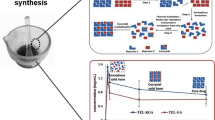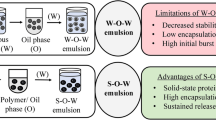Abstract
Ketoprofen (Ket) was intercalated into layered double hydroxides (ZnAlLDH and MgAlLDH) using the ionic exchange method. The drug intercalation was confirmed by X-ray diffraction (XRD) and FTIR spectroscopy. Ket release from the inorganic matrix was studied at pH 7.4 in continuous regime with a flow rate of 0.5 and respectively 1.0 ml/min. The kinetical data were interpreted using the Ritger and Peppas model. The data prove that the release kinetics and mechanism depend on the eluent flow rate. Quantification of gastric tolerance shows that the ulcerogenic effect of the intercalated drug is lower than the one of the raw Ket. The antinociceptive effect of both formulations was studied by the hot-plate method performed on mice. The MgAlLDH_Ket formulation shows a tendency towards a stronger antinociceptive effect than its ZnAlLDH_Ket counterpart during the 210 min recorded period.










Similar content being viewed by others
References
Heyneman CA, Lawless-Liday C, Wall GC. Oral versus topical NSAIDs in rheumatic disease: a comparison. Drugs. 2006;60:555–74.
Marie RG. Epidemiology of nonsteroidal anti-inflammatory drug-associated gastrointestinal injury. Am J Med. 1998;104:23S.
Vueba ML, Pina ME, Veiga F, Sousa JJ, Batista de Carvalho LAE. Conformational study of ketoprofen by combined DFT calculations and Raman spectroscopy. Int J Pharm. 2006;307:56–65.
Kantor TG. Ketoprofen: a review of its pharmacologic and clinical properties. Pharmacotherapy. 1986;6:93–103.
Marie RG. Nonsteroidal anti-inflammatory drugs: practical and theoretical considerations in their selection. Am J Med. 1996;100:31S.
Savage RL, Moller PW, Ballantyne CL, Wells JE. Variation in the risk of peptic ulcer complications with nonsteroidal antiinflammatory drug therapy. Arthritis Rheum. 1993;36:84–90.
Babazadeh M. Synthesis and study of controlled release of ibuprofen from the new acrylic type polymers. Int J Pharm. 2006;316:68–73.
Bonina FP, Puglia C, Barbuzzi T, Caprariis PD, Palagiano F, Rimoli MG, Saija A. In vitro and in vivo evaluation of polyoxyethylene esters as dermal prodrugs of Ketoprofen, naproxen and diclofenac. Eur J Pharm Sci. 2001;14:123–34.
Costantino U, Ambrogi V, Nocchetti M, Perioli L. Hydrotalcite-like compounds: versatile layered hosts of molecular anions with biological activity. Microporous Mesoporous Mater. 2008;107:16–149.
Frunza M, Hritcu D, Popa MI. Intercalation of salicylic acid into ZnAl layered double hydroxides by ion-exchange and coprecipitation method. J Optoelectron Adv Mater. 2009;11:528–34.
Ko JA, Park HJ, Hwang SJ, Park JB, Lee JS. Preparation and characterization of chitosan microparticles intended for controlled drug delivery. Int J Pharm. 2002;249:65–74.
Liu Z, Jiao Y, Wang Y, Zhou C, Zhang Z. Polysaccharides-based nanoparticles as drug delivery systems. Adv Drug Deliv Rev. 2008;60:1650–62.
del Arco M, Gutiérrez S, Martín C, Rives V, Rocha J. Synthesis and characterisation of layered double hydroxides (LDH) intercalated with non-steroidal anti-inflamatory (NSAID) drugs. J. Solid State Chem. 2004;177:3954–62.
del Arco M, Cebadera E, Gutirrez S, Martin C, Montero MJ, Rives V, Rocha J, Sevilla MA. Mg, Al layered double hydroxides with intercalated indomethacin: synthesis, characterisation and pharmacological study. J Pharm Sci. 2004;93:1649–58.
del Arco M, Fernandez A, Martin C, Rives V. Release studies of different NSAIDs encapsulated in Mg, Al, Fe-hydrotalcites. Appl Clay Sci. 2009;42:538–44.
Frunza M, Popa MI, Hulea V. Controlled release of salicylate from the lamella Zn-Al layered double hydroxide nanocomposite. J Optoelectron Adv Mater. 2007;9:3376–8.
Frunza M, Lisa G, Zonda R, Popa MI. Intercalation of Ketoprofen into Mg-Al hydrotalcites. Synthesis and characterization. Rev Chim-Bucharest. 2008;59:409–12.
Li B, He J, Evans DG, Duan X. Inorganic layered double hydroxides as a drug delivery systems intercalation and in vitro release of fenbufen. Appl Clay Sci. 2004;27:199–207.
Silion M, Popa MI, Lisa G, Hritcu D. New hybrid compounds containing intercalated ciprofloxacin into layered double hydroxides: synthesis and characterization. Rev Roum Chim. 2008;53:827–31.
del Hoyo C. Layered double hydroxides and human health: an overview. Appl Clay Sci. 2007;36:103–21.
Tarnawski AS, Ahluwalia A, Gandhi V, Deng X, Xiong X. Hydrotalcite protects aging gastric mucosa against NSAID- and ethanol-induced injury by preserving endothelial and progenitor cells. Underlying molecular mechanisms include activation of survivin and VEGF. Gastroenterology. 2010;138:S-721.
Yu BP, Sun J, Li MQ, Luo HS, Yu JP. Preventive effect of hydrotalcite on gastric mucosal injury in rats induced by taurocholate. World J Gastroenterol. 2003;9:1427–30.
Carlino S. The intercalation of carboxylic acids into layered double hydroxides: a critical evaluation and review of the different methods. Solid State Ionics. 1997;98:73–84.
Silion M, Popa MI. Preparation and characterization of ketoprofen-layered double hydroxide compounds. J Optoelectron Adv Mater. in press 2010.
Beldie C, Dumitriu S, Aelenei N, Popa M, Popa MI, Bioactive DumitriuD, Polymers LX. Kinetics of delayed release neomycin-xanthan complex. Biomaterials. 1989;10:622–4.
Jaba IM, Ionescu D, Popa MI, Silion M, Tamba B, Mungiu OC. The analgesic effect and local tolerance of new anorganic nanohybrid systems with ketoprofen. InfoMedica. 2008;3:10–3.
Tuo B, Wen G, Wang X, Liu X, Dong H. Estrogen potentiates prostaglandin E2-stimulated duodenal mucosal bicarbonate secretion in mice. Gastroenterology. 2010;138:S-721.
Krylova SG, Fomina TI, Efimova LA, Zueva EP, Khotimchenko MIu, Razina TG, Amosova EN, Lopatina KA, Khotimchenko IuS. Antiulcer effect of calcium pectate on model of chronic gastric ulcer in rats. Eksp Klin Farmakol. 2009;72:35–8.
Konturek SJ, Brzozowski T, Garlicki J, Majka J, Stachura J, Nauert C. Intragastric pH in the gastroprotective and ulcer-healing activity of aluminum-containing antacids. Digestion. 1991;49:140–50.
Carstens E. Quantitative experimental assessment of pain and hyperalgesia in animals and underlying neural mechanisms. In: Carli G, Zimmermann M, editors. Progress in Brain Research, vol 110. Amsterdam: Elsevier Science B.V. 1996. p. 17–31.
Derbyshire SWG. Assessing pain in animals. In: Basbaum AI, Kaneko A, Shepherd GM, Westheimer G, Albright TD, Masland RH, Dallos P, Oertel D, Firestein S, Beauchamp GK, Bushnell MC, Kaas JH, Gardner Esther, editors. The senses: a comprehensive reference, vol. 5. Oxford: Elsevier Inc; 2008. p. 969–74.
Williams M. Use of animal models for drug discovery. In: Enna SJ, Bylund DB, editors. xPharm: the comprehensive pharmacology reference. New York: Elsevier; 2008. p. 1–7.
Hunskaar S, Hole K. The formalin test in mice: dissociation between inflammatory and non-inflammatory pain. Pain. 1987;30:103–14.
Olanrewaju J, Newalkar BL, Mancino C, Komrneni S. Simplified synthesis of nitrate form of layered double hydroxide. Mater Lett. 2000;45:307–10.
Xu ZP, Zeng HC. Sulfate-functionized carbon/metal-oxide nanocomposites from hydrotalcite-like compounds. Nano Lett. 2001;1:703–6.
Xu ZP, Zeng HC. Abrupt structural transformation in hydrotalcite-like compounds Mg1−xAlx(OH)2(NO3)x·nH2O as a continuous function of nitrate anions. J Phys Chem B. 2001;105:1743–9.
del Arco M, Fernández A, Martín C, Rives V. Intercalation of mefenamic and meclofenamic acid anions in hydrotalcite-like matrices. Appl Clay Sci. 2007;36:133–40.
Maestrelli F, Zerrouk N, Cirri M, Mennini N, Mura P. Microspheres for colonic delivery of ketoprofen-hydroxypropyl-β-cyclodextrin complex. Eur J Pharm Sci. 2008;34:1–11.
Cavani F, Trifiro F, Vaccari A. Hydrotalcite-type anionic clays: preparation, properties and application. Catal Today. 1991;11:173–301.
Kanan S, Swamy CS. Synthesis and physicochemical characterization of cobalt aluminium hydrotalcite. J Mater Sci Lett. 1992;11:1585–7.
Xu ZP, Zeng HC. Interconversion of brucite-like and hydrotalcite-like phases in cobalt hydroxide compounds. Chem Mater. 1999;11:67–74.
Aelenei N, Popa MI, Novac O, Lisa G, Balaita L. Tannic acid incorporation in chitosan-based microparticles and in vitro controlled release. J Mater Sci Mater Med. 2009;20:1095–102.
Dashevsky A, Mohamad A. Development of pulsatile multiparticulate drug delivery system coated with aqueous dispersion Aquacoat® ECD. Int J Pharm. 2006;318:124–31.
Mastiholimath VS, Dandagi PM, Jain SS, Gadad AP, Kulkarni AR. Time and pH dependent colon specific, pulsatile delivery of theophylline for nocturnal asthma. Int J Pharm. 2007;28:49–56.
Rokhade AP, Shelke NB, Patil SA, Aminabhavi TM. Novel interpenetrating polymer microspheres of chitosan and methylcellulose for controlled release of theophylline. Carbohydr Polym. 2007;69:678–87.
Serra L, Domenech J, Peppas NA. Drug transport mechanisms and release kinetics from moleculary designed poly(acrylic acid-g-ethylene glycol) hydrogels. Biomaterials. 2006;27:5440–51.
Ritger PL, Peppas NA. A simple equation for description of solide release. II. Fickian and anoumalous release from swellable devices. J Control Release. 1987;5:37–42.
Lee WF, Jou LL. Effect of the intercalation agent content of montmorillonite on the swelling behavior and drug release behavior of nanocomposite hydrogels. J Appl Polym Sci. 2004;94:74–82.
Costantino U, Casciola M, Massinelli L, Nocchetti M, Vivani R. Intercalation and grafting of hydrogen phosphates and phosphonates into synthetic hydrotalcites and a.c.-conductivity of the compounds thereby obtained. Solid States Ionics. 1997;97:203–12.
Playle AC, Gumming SR, Llewellyn AF. The in vitro antacid and anti pepsin activity of hydrotalcite. Pharm Acta Helv. 1974;49:298–302.
Pawlaczyk J, Kokot Z, Rafinska A. In vitro study of the antipeptic activity of antacid preparations. Acta Pol Pharm. 1985;42:153–8.
Dreyer M, Marwinski D, Wolf N, Damman HG. Acid suppression profile of hydrotalcite in man. Arzneim-Forsch. 1991;41:738–41.
Tarnawski AS, Tomikawa M, Ohta M, Sarfeh IJ. Antacid talcid activates in gastric mucosa genes encoding for EGF and its receptor. The molecular basis for its ulcer healing action. J Physiol Paris. 2000;94:93–8.
Acknowledgments
This research was financially supported by the European Social Fund—„Cristofor I. Simionescu“ Postdoctoral Fellowship Programme (ID POSDRU/89/1.5/S/55216), Sectoral Operational Programme Human Resources Development 2007–2013.
Author information
Authors and Affiliations
Corresponding author
Rights and permissions
About this article
Cite this article
Silion, M., Hritcu, D., Jaba, I.M. et al. In vitro and in vivo behavior of ketoprofen intercalated into layered double hydroxides. J Mater Sci: Mater Med 21, 3009–3018 (2010). https://doi.org/10.1007/s10856-010-4151-0
Received:
Accepted:
Published:
Issue Date:
DOI: https://doi.org/10.1007/s10856-010-4151-0




